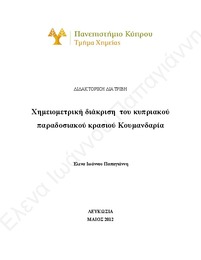Χημειομετρική διάκριση του κυπριακού παραδοσιακού κρασιού Κουμανδαρία

Date
2012-05Author
Ιωάννου-Παπαγιάννη, Έλενα Λ.Publisher
Πανεπιστήμιο Κύπρου, Σχολή Θετικών και Εφαρμοσμένων Επιστημών / University of Cyprus, Faculty of Pure and Applied SciencesPlace of publication
ΚύπροςCyprus
Google Scholar check
Keyword(s):
Metadata
Show full item recordAbstract
Η Κουμανδαρία είναι οίνος λικέρ κυπριακής καταγωγής, το όνομά του συμβολίζει τη γεωγραφική του προέλευση, αφού παραγόταν στην περιοχή Commanderie της Λεμεσού.
Στόχος της διδακτορικής εργασίας είναι η ανάπτυξη μεθόδων προσδιορισμού ικανές να εντοπίσουν τα ιδιαίτερα χαρακτηριστικά ώστε να διακρίνουν το παραδοσιακό κρασί Κουμανδαρία από άλλα εγχώρια κόκκινα κρασιά αλλά και από γλυκά κρασιά άλλων χωρών, που παράγονται με παρόμοια διαδικασία και πιθανόν να έχουν κοινά συστατικά.
Για το χαρακτηρισμό της Κουμανδαρίας λήφθηκαν φάσματα με τη χρήση Φασματοσκοπίας Υπερύθρου, FTIR και Φασματοσκοπία Πυρηνικού Μαγνητικού Συντονισμού, 1H-NMR σε συμπυκνωμένα δείγματα. Η συμπύκνωση των δειγμάτων έγινε με δύο τεχνικές: λυοφιλίωση και ροή αζώτου.
Με στατιστικό πρόγραμμα WinDAS κατά την Ανάλυση των Κυρίων Συνιστωσών (PCA) στα φάσματα Υπερύθρου των λυοφιλωμένων δειγμάτων, η ομάδα των Κουμανδαριών αποτελεί ξεχωριστή ομάδα με επιτυχία και αθροιστικό ποσοστό διακύμανσης της πρώτης και δεύτερης κύριας συνιστώασς 88.7% σε ολόκληρη την περιοχή φάσματος. Στα φάσματα Υπερύθρου των συμπυκνωμένων μετά από ροή αζώτου, η 1η κύρια συνιστώσα ταξινόμησε την ομάδα των Κουμανδαριών σε ξεχωριστή ομάδα με ποσοστό επιτυχίας 85.0% σε ολόκληρη την περιοχή φάσματος με κύριο χαρακτηριστικό διάκρισης την ομάδα των σακχάρων. Η χημειομετρική επεξεργασία των φασμάτων Πυρηνικού Μαγνητικού Συντονισμού (1H-NMR) δεν έφτασε την επιτυχία των φασμάτων Υπερύθρου. Το στατιστικό πρόγραμμα SCAN διέκρινε ως καλύτερη τεχνική συμπύκνωσης των δειγμάτων τη ροή αζώτου αφού κατά τη δόμηση του μοντέλου με Δένδρα Ταξινόμησης και Παλινδρόμησης (CART) το ποσοστό ορθής πρόβλεψης ήταν 100.0% για την ομάδα των Κουμανδαριών και 88.9% για την ομάδα των Κουμανδαριών του εμπορίου ενώ τα ποσοστά κατά τη διασταυρωτική επιβεβαίωση του μοντέλου ήταν 72.0% και 77.8% αντίστοιχα. Commandaria is a liqueur wine, which has originated in Cyprus. Its name symbolizes its geographical origin, since it is produced in the region Commanderie in the district of Limassol.
The aim of this doctoral work is the development of methods, capable for determining and identifying the specific characteristics of the traditional wine Commandaria that distinguishes it from other domestic red wines but also from other sweet wines of other countries, produced through similar processes that may have common ingredients.
For the differentiation and uniqueness of Commandaria, a lot of spectra were studied using Infrared Spectroscopy with Fourier Transform (FTIR) and Nuclear Magnetic Resonance Spectroscopy (1H-NMR) in concentrated samples. The concentration of the samples was done by two techniques: lyophilization (freeze-drying) and nitrogen flow.
The Principal Component Analysis in FTIR spectra, using the statistical program WinDAS, has discriminated freeze-drying Commandaria in separate group using PC2, with covariance accounting to 88.7 %, in the region 400-4000cm-1. On the other hand, the FTIR spectra of the concentrated samples with the nitrogen flow technique, has discriminated the group of Commandaria in a separate group using only PC1, with covariance accounting to 85.0 %, in the same region, with the group of Sugars to be the main characteristic.
The Principal Component Analysis in 1H-NMR spectra didn’t reach the same good results as those of FTIR spectra.
The statistical program SCAN singled out the nitrogen flow method as the best method for the technical concentration of the samples, since in the structuring of the model with Classification and Regression Trees (CART), the correct recognition for the group of Commandaria was 100% and for the group of commercial wines type Commandaria was 88.9%, while the correct prediction in cross-validation class assignments was 72.0% and 77.8 % respectively.
